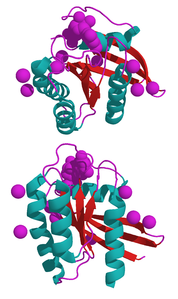G protein Ras
| GTPase NRas | ||
|---|---|---|

|
||
| with GDP and Mg 2+ according to PDB 3CON | ||
| Properties of human protein | ||
| Mass / length primary structure | 189 amino acids; 21.2 kDa | |
| Cofactor | GDP / GTP | |
| Identifier | ||
| Gene names | NRAS ; NRAS1 | |
| External IDs | ||
| Occurrence | ||
| Homology family | HBG009351 | |
| Parent taxon | Chordates | |
| Orthologue | ||
| human | mouse | |
| Entrez | 4893 | 18176 |
| Ensemble | ENSG00000009307 | ENSMUSG00000027852 |
| UniProt | P01111 | Q3TMF4 |
| Refseq (mRNA) | NM_002524 | NM_010937 |
| Refseq (protein) | NP_002515 | NP_035067 |
| Gene locus | Chr 1: 115.05 - 115.06 Mb | Chr 3: 102.86 - 102.87 Mb |
| PubMed search | 4893 |
18176
|
Ras ( Ra t s arcoma) is a proto- oncogene that codes for a so-called small G protein (monomer) . It was described in 1981 by the American molecular biologist Robert Allan Weinberg , making it the first proto-oncogene to be discovered.
function
Ras is a central link in various signal transduction pathways that regulate growth and differentiation processes. As a monomeric GTP- binding protein, it takes on the function of a regulated molecular switch, with which cellular processes can be switched on or off. Ras changes between two states in which it has either bound GTP (RasG) or the GTP is hydrolyzed to GDP (Ras). The basis of this molecular switch function is based on different protein conformations in the binding of GTP or GDP. Ras can only interact with other signal proteins (so-called effectors) in the GTP-bound state, which in turn mediate signal transmission. Since both the intrinsic GTP hydrolysis ( GTPase activity) are and the intrinsic nucleotide basically very slow processes, the life of the active and inactive state of Ras about is nucleotide -Austauschfaktoren (guanine-nucleotide exchange factor, GEF ) and GTPase-activating Proteins (GAP) controlled.
Signal transduction pathway
- using the example of the receptor tyrosine kinase signal transduction pathway
The binding of a ligand to a receptor tyrosine kinase (RTK) causes its dimerization, which results in the transphosphorylation of the receptor. The phosphorylated tyrosines on the RTK now serve as a docking point for the cytosolic adapter protein Grb2, which in turn is constitutively associated with the Ras-GEF SOS (Son Of Sevenless). The autophosphorylation of the receptor thus leads to the recruitment of the Grb2 / SOS protein complex to the membrane and thus into the immediate vicinity of Ras. SOS now activates Ras by enabling the release of GDP and the subsequent exchange with GTP, which is present in the cytosol in about ten times higher concentration. Activated Ras-GTP can now bind the effector protein Raf kinase. The membrane recruitment leads to the activation of Raf , among other things due to a change in conformation. In return, active Raf kinase can now activate the MEK kinase through phosphorylation. Active MEK in turn phosphorylates and activates the Erk kinase . Active Erk ultimately reaches the cell nucleus, where it can activate a number of transcription factors through phosphorylation.
Cancer research
The fact that point mutations in the ras gene are found in 20 to 30 percent of all human tumors underscores the important role of Ras in controlling cell growth . The oncogenic significance of ras is further reinforced by the observation that activating NRAS mutations typically occur as escape mechanisms after treatment with BRAF inhibitors. The point mutations of the ras genes all lead to the loss of the GTPase binding activity of Ras, which can no longer be excited even in the presence of GTPase activating proteins (GAP). Since the change from the GTP-bound form to the GDP form is blocked, there is an accumulation of active Ras and thus a permanent growth-stimulating signal in the cell . Great efforts have been made to understand the molecular basis of the switch function of Ras proteins and to develop anti-tumor drugs directed against oncogenic Ras. Some forms of Ras such as B. KRAS even play a decisive role in whether certain oncological drugs are effective.
See also
literature
- Jeremy M. Berg, John L. Tymoczko, Lubert Stryer : Biochemistry. 6 edition, Spektrum Akademischer Verlag, Heidelberg 2007, ISBN 978-3-8274-1800-5 .
- Donald Voet, Judith G. Voet: Biochemistry. 3rd edition, John Wiley & Sons, New York 2004, ISBN 0-471-19350-X .
- Bruce Alberts , Alexander Johnson, Peter Walter, Julian Lewis, Martin Raff, Keith Roberts: Molecular Biology of the Cell. 5th edition, Taylor & Francis, New York 2008, ISBN 978-0-8153-4106-2 .
Individual evidence
- ↑ Carolina Hertzman Johansson, Suzanne Egyhazi Brage: BRAF inhibitors in cancer therapy. In: Pharmacology & Therapeutics. Volume 142, No. 2, May 2014, pp. 176-182, doi: 10.1016 / j.pharmthera.2013.11.011 .